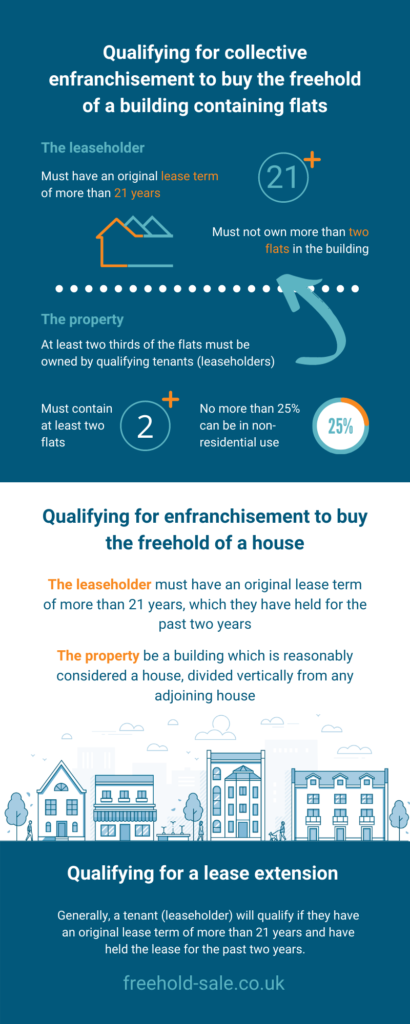If you’re a freeholder of a residential property or a building containing two or more flats, you’ll need to be aware of enfranchisement and collective enfranchisement. Both are legal rights provided to leaseholders under Landlord and Tenant law, which must be upheld by freeholders. In return, freeholders will be entitled to receive a premium as compensation for their financial loss.
Enfranchisement
What is enfranchisement?
Enfranchisement refers to a transaction in which a leaseholder purchases the freehold of their house. This is a legal right provided to leaseholders under the Leasehold Reform Act 1967 as amended by the Commonhold and Leasehold Reform Act 2002.
How do you qualify for enfranchisement?
To qualify for enfranchisement to acquire the freehold of a house, both the leaseholder and the property will need to meet a variety of qualification criteria.
Does my property qualify for enfranchisement?
Your property will qualify for enfranchisement if the building can be reasonably considered a house, divided vertically from any adjoining house. If the property has been divided into flats, it is still eligible for enfranchisement if the leaseholder has the lease for the whole house. Some commercial properties may also qualify for enfranchisement, such as shops with a flat above where the leaseholder has a lease for the entire property.
Does my leaseholder (tenant) qualify for enfranchisement?
Leaseholders will qualify for enfranchisement if they have a long lease with an original term of at least 21 years or with a right to renewal. Furthermore, this lease must have been held by the leaseholder for the past two years. In instances where a qualifying leaseholder dies, their personal representatives are also eligible to apply for enfranchisement for up to two years from when probate has been granted, or from obtaining a letter of administration.
How do leaseholders apply for enfranchisement to acquire the freehold of a house?
Leaseholders can start the process of applying for enfranchisement by serving a “Tenants Notice” on the freeholder, or intermediate freehold landlord should there be one in place. Service of this notice creates a contract between both sides to grant and accept the freehold transfer. However, the Tenant’s Notice must be served in the prescribed form as set out in The Leasehold Reform (Enfranchisement and Extension) Regulations 1967.
Significantly, leaseholders do not need to include a proposed price in the notice to acquire the freehold. Rather, this price must be agreed using the formula in the legislation. However, the current formula and procedure are somewhat unclear, which has enabled unscrupulous freeholders to take advantage by requesting excessive premiums from their leaseholders.
Unsurprisingly, this led to a public outcry, particularly from leaseholders already severely impacted by the ground rent scandal, which trapped them in unsellable homes. Consequently, the Law Commission undertook a robust investigation into the enfranchisement valuation process. The primary outcome was the proposal of three “options” for reforming the valuation process.
The proposed options have been devised to make the process clearer and fairer which will ultimately save leaseholders money while ensuring that freeholders are suitably compensated. While these solutions are currently under government review, we can expect that amendments to enfranchisement law will be made imminently.
What do you do if you’re served notice for enfranchisement?
If you are served notice for enfranchisement you can either admit the claim and negotiate the valuation (if required) or challenge the notice. To proceed with the former, you are entitled to ask for a deposit that equals three times the annual ground rent for the property in your counter-notice. If, however you wish to challenge, you must serve a counter-notice which includes your reasoning for the dispute. This notice must be served to the leaseholder within two months of the date that you received the tenant’s notice. Once a price for the freehold has been agreed, the completion of the sale must take place within four weeks.
Collective Enfranchisement
What is collective enfranchisement?
Collective enfranchisement is the right outlined in the Leasehold Reform Housing & Urban Development Act 1993, for leaseholders of a building or part of a building that contains flats to collectively buy the freehold of that property.
Does my freehold property qualify for collective enfranchisement?
In order to qualify for collective enfranchisement, the property must be a self-contained building or part of a building, that contains at least two flats. In instances where the property is part of a building, there must be a vertical division making it independent to that part (or accessible without interruption to that part). At least two-thirds of the flats must be owned by qualifying leaseholders, and half the qualifying leaseholders in the building must participate. Lastly, no more than 25% of the building can be in non-residential use, such as offices or shops.
Do my leaseholders qualify for collective enfranchisement?
Leaseholders will qualify for collective enfranchisement when they have a long lease with an original lease term of more than 21 years. However, leaseholders who own more than two flats in the building (either jointly or in their own name) will not qualify.
How do leaseholders apply for collective enfranchisement?
Leaseholders who wish to apply for collective enfranchisement must do so through service of a Section 13 Notice on the freehold landlord. Within this notice, leaseholders must state the name of their Nominee Purchaser. This person will action all stages of the collective enfranchisement and on completion, will be responsible for the landlord covenants within the leases. The Nominee Purchaser can be one of the lessees applying for collective enfranchisement or a third party.
What do you do if you’re served notice for collective enfranchisement?
If you are served initial notice, you are entitled to request evidence of the participating leaseholder’s titles to their flats. This request must be made within 21 days of receiving the initial notice and a further 21 days will be given to the Nominee Purchaser to respond. No matter whether you choose to make a request for evidence or not, you must serve a counter-notice by the date specified in the initial notice. This date will be at least two months from the date the initial notice was served.
Lease Extensions
It’s common for leaseholders, particularly those of flats, to opt for a lease extension rather than purchasing the freehold of their building. This is a legal right provided to leaseholders under the Leasehold Reform, Housing and Urban Development Act 1993, which ensures that they can continue to live in their property for an agreed number of years.
How do you qualify for a lease extension?
Qualifying to extend a lease is fairly straightforward. Generally, a leaseholder (tenant) will qualify if they have a long lease with an original term of more than 21 years, which they have held for the past two years
How do leaseholders apply to extend their lease?
Qualifying leaseholders can have two options when it comes to extending their lease. Firstly, some may be able to negotiate a lease extension with their freehold landlords directly. This can sometimes result in a better outcome for both the leaseholder and the freeholder. When this isn’t a suitable option, leaseholders may take the statutory route by service of a Section 42 Notice to their freeholder. This can be served by post to the freehold landlord’s last known address in England or Wales, or it can be delivered in person.
Section 42 of the Leasehold Reform, Housing and Urban Development Act 1993 provides leaseholders with an extension of 90 years on top of their remaining lease term. Furthermore, if the leaseholder pays ground rent, this will be reduced to zero (referred to as peppercorn ground rent). Section 42 Notices must be served in the prescribed form without faults, as this may render the document invalid. As a result, leaseholders may have to wait another 12 months to apply.
Leaseholders must propose a premium payable to extend their lease in the Section 42 Notice. This should be based on a professional valuation, although this is not a legal requirement. However, as above, imminent enfranchisement valuation reform is likely to alter the way in which lease extensions are calculated. Currently, the applying leaseholder is also liable for the freehold landlord’s reasonable costs from the date they receive the notice.
Qualifying for enfranchisement – Infographic

In summary
Qualifying for collective enfranchisement – buying the freehold of a building containing flats
The leaseholder must:
- Have an original long lease term of more than 21 years
- Must not own more than two flats in the building
The property must:
- Contain at least two flats
- At least two-thirds of the flats must be owned by qualifying tenants (leaseholders)
- No more than 25% can be in non-residential use
Qualifying for enfranchisement – buying the freehold of a house
The leaseholder must:
- have an original long lease term of more than 21 years
- Must have held the lease for the past two years
The property must:
- Be a building which is reasonably considered a house, divided vertically from any adjoining house
Qualifying for a lease extension
Generally, you will be a qualifying tenant (leaseholder) if you have an original long lease term of more than 21 years and have held the lease for the past two years.
Further reading – Find out what happens if you’re served a Right to Manage Notice by your leaseholders in, “A Landlord’s Guide to Right to Manage”.
This freeholder resource was originally published on 2nd July 2018 and updated on 7th February 2020


